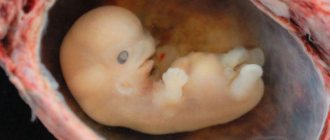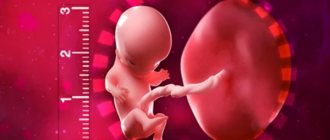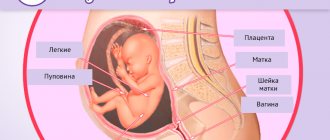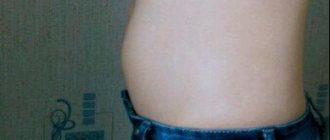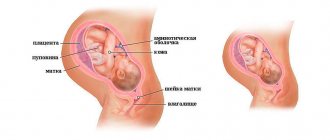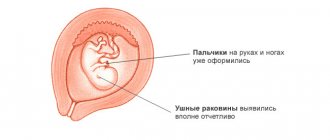The 39th week of pregnancy means that your baby is fully mature and ready to be born. Your pregnancy is approaching the final stage - childbirth.
On the one hand, there is a feeling of fatigue and a desire to quickly pick up the baby in your arms, on the other – anxiety. It’s not just the moment of childbirth that worries you, but the rest of your life.
For now, future parents have little idea of how life will change, what they will have to give up, what rules to introduce. In fact, this doesn’t matter anymore, because very soon a child will appear in your house.
Fetal development
Your child is fully viable, all his organs are mature and ready to perform their functions outside the mother’s body.
This is what your baby looks like at 37 weeks
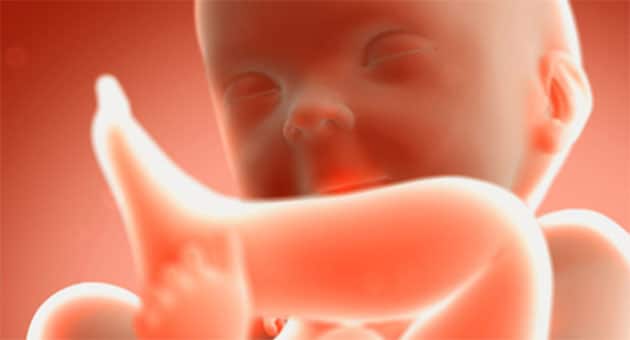
Now he looks exactly like the kids in the photos you've probably been adoring over the past few months.
His skin is pink, vellus hair can remain only in folds, on his forehead and on his shoulders. The nails extend beyond the edge of the fingers and are quite sharp.
The baby’s weight gain should have stopped by now - this is how nature intended it to make it easier for the mother to give birth.
The space in the mother’s stomach is becoming less and less, the baby is not moving very actively, as if gaining strength before giving birth. Mom will notice a decrease in the activity of the belly, there is no need to panic, but also lose sight of it. There should still be at least 10 large movements.
The brain is responsible for the baby’s actions and his perception of the environment. He actively reacts to what is happening around him, recognizes voices and music.
Question answer
What are the warning signs of labor during a second pregnancy?
– The harbingers of the second birth are similar to the first birth. The only difference is that all the signs can appear more strongly and more quickly.
The mucus plug has come off, is it time to go to the maternity hospital?
– The mucus plug in multiparous women is more voluminous, but it can come off a few days before birth, during childbirth, or directly with the release of amniotic fluid.
The expected due date is already close, but the belly has not dropped
– A drooping abdomen is not always a sign of imminent labor. So, in primiparous women, the uterus may drop as early as 35-36 weeks, but labor will begin at the scheduled time. In multiparous women, the stomach may sag immediately on the day of birth.
My stomach turns to stone, what does this mean?
– A stony belly is a sign of increased uterine tone, which means the body is preparing for childbirth. If there are no other warning signs of labor, then you are most likely experiencing training contractions.
39 weeks pregnant, constantly pulling in the lower back, why?
– The cause of nagging pain in the lower back is the action of a special hormone – relaxin. It is responsible for softening the ligaments and mobility of the symphysis pubis, which helps prepare the pelvis for the passage of the baby through the birth canal.
Editor's choice: At what week will the test show pregnancy - early detection
How to induce labor?
– Any active physical activity (walking up the stairs, cleaning the house, washing windows) can cause the onset of labor. Stroking the nipples can also help - such irritation reflexively provokes uterine contractions.
How to speed up labor?
– The most effective way to speed up labor is to put in an IV with oxytocin, a special hormone responsible for the onset of labor and stimulates uterine contractions. However, you can resort to another method - puncturing the amniotic sac, this also provokes the uterus to contract.
When can you give birth after a caesarean section?
– Caesarean section is very different from natural childbirth, because it is a full-fledged surgical intervention in the female body. The main factor is the condition of the scar on the uterus after this operation. If the scar has healed well and more than a year has passed since the previous birth, the woman can become pregnant and count on a natural birth in the future. However, it is better to wait at least 2 years before planning a new pregnancy.
Ultrasound at 39 weeks of pregnancy
At 39 weeks of pregnancy, an ultrasound is not required. Only in certain cases can a doctor recommend undergoing an examination to determine the position of the fetus, the amount of amniotic fluid, assessing blood flow in the placenta, the length of the umbilical cord, the presence of nodes on it, and entanglement.
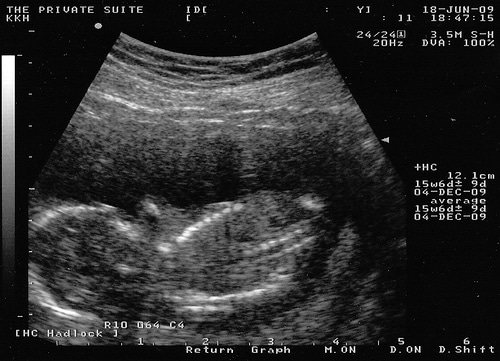
The condition of the uterus, cervix, its degree of maturity and readiness for childbirth will also be assessed.
Umbilical cord and placenta at 39 weeks
During an ultrasound, the sonologist pays special attention to the examination of the following organs:
- Umbilical cords;
- Placenta.
Location of the placenta
It is very important to determine whether the placenta is wrapped around the baby’s torso and neck. Umbilical cord entanglement occurs in 30–40% of children. Experts no longer consider this location of the umbilical cord a problem.
The length of this organ at this stage is 55–65 cm, while the thickness is 1–2 cm. When the umbilical cord is entwined around the fetus, it is removed from the baby’s head immediately after birth. A true umbilical cord knot is formed only in 1% of cases.
Structure of the placenta
This organ is considered old from the 39th week (2nd - 3rd degree of maturity). Even during this period of pregnancy, antibodies necessary for the normal functioning of the baby's immune system pass through the placenta. The state of the placenta is an important indicator on ultrasound in the third trimester. It is important to exclude possible pathologies of this organ.
The most dangerous complication at the end of pregnancy is uterine bleeding. Its cause is displacement of the placenta and uterus. With ultrasound examination, this pathology (if present) is easy to determine. In this case, the sonologist diagnoses “placenta previa.” If it is present, hospitalization of the expectant mother is considered mandatory. She is placed in the pregnancy pathology department at the maternity hospital.
What happens in your body at 39 weeks?
The main changes that occur in the body at week 39 relate to the preparation of the genital organs for childbirth. The cervix softens and shortens. The tissue connecting the pelvic bones softens, and the excitability of the uterus increases. All this is necessary for the baby to pass through the birth canal as quickly but non-traumaticly as possible.
The abdomen descends, the presenting part of the fetus is pressed against the entrance to the pelvis. Pressure on the bladder and intestines leads to a number of inconveniences, but previously tormented heartburn and shortness of breath practically disappear, the woman’s general condition improves - she can breathe and eat more freely.
The expectant mother may notice a slight weight loss - the intestines are working more actively, and the bladder is emptied more often.
Carefully monitor how you feel - any pain in the abdomen, liquid discharge from the genital tract, or thick yellowish mucous streaked with blood may indicate the onset of labor. There is no need to be afraid - childbirth at this stage is normal.
Second births: main differences
In the vast majority of cases, the second birth is easier than the first. This is due to the fact that the woman in labor is more experienced:
- A woman is psychologically better prepared for childbirth: she knows what will happen and how;
- A woman knows how to breathe correctly during contractions, how to push - all this not only facilitates the birth process, but also speeds it up;
- Contractions last on average about 8 hours, but often they can take only 2-4 hours, while during the first birth, the period of cervical dilatation is the longest and can take up to 12 hours. This is explained by the fact that the cervix is more elastic, it is able to contract and open at the same time, which significantly reduces the time of contractions.
- The period of pushing is less painful, since the body “remembers” the previous birth, which leads to the rapid appearance of pushing, as well as the rapid movement of the child along the birth canal. Thus, the period of pushing takes no more than 20 minutes, whereas in primiparous women this period can take up to 2 hours.
Editor's choice: What does the stomach feel like during pregnancy?
How you feel at 39 weeks
The closer to childbirth, the greater the range of feelings the expectant mother may experience. She is afraid of childbirth, but is really looking forward to the moment when she can take the baby in her arms and put it to her breast.
It becomes easier to breathe, but other troubles appear, for example, it is difficult to remain in a sitting position for a long time - a drooping baby puts pressure on the pelvic organs.
At 39 weeks you will likely have a thick yellow discharge streaked with blood. This is how the mucus plug comes away, which served as a barrier throughout pregnancy and did not allow infection to reach the baby.
Changes in the gastrointestinal tract may include loose stools and loss of appetite.
Uterine contractions are becoming more frequent. The main thing is not to confuse them with true contractions. With true contractions, the intervals between them are reduced, and the duration of each increases over time. Amniotic fluid may break.
Whatever happens to you in the 39th week, do not forget to be attentive to your condition.
Baby parameters on ultrasound of the third trimester
When performing ultrasound diagnostics by the 39th week, the baby is prescribed the following basic measurements:
- Weighing;
- Fetometry;
- Determination of height;
- Measuring bones and their length.
Normally, the baby’s parameters at 39 weeks are:
- Biparietal size of the baby – 88 – 102 mm;
- The abdominal circumference normally reaches 310 – 374 mm;
- The fronto-occipital size reaches approximately 109 – 129;
- The circumference of a child's head has parameters of 311 - 359 mm.
During the diagnostic process of the third trimester, the child’s bones have the following indicators, taking into account the norm:
- Femur – 69 – 79 mm;
- The shin bone is approximately 60 – 70 mm;
- Baby’s humerus – 61 – 71 mm;
- The bones of the forearm during this period are 53–61 mm.
The baby's height reaches a length of 50 - 53 cm (measured from the crown to the heels).
The baby's weight at 39 weeks is 3 - 3.5 kg.
Discharge from the genital tract
Light milky discharge with a slight sour odor is considered normal at this stage of pregnancy. The appearance of a slight admixture of mucus indicates the passage of the mucus plug and is also normal.
Yellow or green discharge with an unpleasant odor should cause alarm - inflammation in the vagina should not be allowed now, it is dangerous for infection of the fetus and the development of postpartum complications.
Bloody discharge is also a bad sign; as a rule, it appears during placental abruption and requires immediate medical intervention.
Sex
Should you have sex at 39 weeks pregnant? Doctors give different answers to this question, but it cannot be said that it is categorically prohibited. You need to rely only on how the expectant mother feels. Most women get very tired towards the end and their desire disappears; some, on the contrary, really need the intimacy of their spouse. Modern doctors and scientists have proven that orgasm can stimulate contractions; for example, in Europe they even recommend making love after regular contractions, in order to develop the cervix to its full dilation. Despite this, the future father needs to be gentle and extremely careful, because if the mother begins to feel pain, sex will have to be interrupted.
Photos of bellies at 39 weeks
Important at 39 weeks
It would be a good idea to check if everything is ready for the maternity hospital. Leave the bag (it’s better if it’s a bag - these are the sanitary requirements in most maternity hospitals) in a visible place to make life easier for yourself and your loved ones. Be sure to prepare all the documents and carry them with you everywhere.
Many women recall that before giving birth they were visited by an irresistible desire to put things in order, and they had enough strength to do this, despite the fact that a couple of days ago they only wanted to rest. Therefore, if you suddenly have a surge of energy, most likely your trip to the maternity hospital is just around the corner.
Don't neglect older children if you have them. Talk and explain where and why you will leave home. Tell them that you will return with your brother or sister, involve them in the general bustle, buying things, preparing the room.
Nutrition at 39 weeks of pregnancy
Having grown up one morning at the thirty-ninth week, you will feel that it has become much easier for you to breathe, and the sensations are reminiscent of those that were around the twentieth weeks. Yes, of course, the tummy has not disappeared anywhere; on the contrary, it reminds you in every possible way that you are about to give birth, and the load on the spine itself has not become less. The most surprising thing is that at the thirty-ninth week your weight will not increase if the nutrition at the 39th week is correct, and the weight may even decrease.
And all this happens because the baby’s head descends down the birth canal, while it is pressed against the entrance to the pelvis, which frees up space for the liver, heart, stomach and lungs. Also, due to the next hormonal surge and in anticipation of a miracle, secretion of all mucous membranes appears, in connection with this, abundant discharge appears, especially in the genital tract and in the nasopharynx. In addition, due to changes in hormonal levels, changes occur in the intestines; during the thirty-ninth week, loose stools may occur, so it is very important to cleanse the intestines before childbirth.
Therefore, many women in the 39th week of pregnancy are very, very concerned about nutrition. What and how to eat during the last weeks, because every day can end in childbirth. Of course, the environmental situation today is not the best, and there are quite a lot of stressful situations today. But in any case, no matter what, both you and your baby should receive vitamins at 39 weeks of pregnancy. This is very important, it is also important that you get the maximum amount of nutrients.
So, for every pregnant woman, nutrition, especially in the last weeks of pregnancy, plays an important role, so pay special attention to ensuring that the body gets enough protein. Although some experts claim that a diet during pregnancy at 39 weeks is simply necessary, this is not at all true, because the diet includes a complete absence of protein. And as everyone knows, protein is a building material for human tissue; it is what contributes to the growth of the baby.
Carbohydrates will not interfere with your diet during the 39th week of pregnancy; they give your body energy and strength. And also carbohydrates will help you raise your glucose levels. In general, you need to eat everything natural and healthy. You shouldn’t overdo it with food, as this can negatively affect future births; it will be more difficult and difficult for you to give birth if you are overweight. Therefore, eat often, but little by little, and most importantly, eat more vitamins and nutrients.


